 Based on the "Synopsis of the Brazilian orchid genus Grobya, with the description of two new species"
(*) Fabio de Barros and Ricardo de Azevedo
Lourenço,
Botanical Journal of the Linnean Society, 2004, 145, 119-127 |
All
known species of this small orchid genus only occur in the southern
and south-eastern Brazil with an occurrence in the state of Bahia.
It has been established by Lindley (l835) based on Grobya
amherstiae Lindl. Besides the type, two species were also
described during the 19th century: G. galeata Lindl.
and G. fascifera Rchb. f. Until last year, they were
the only species considered as valid. However while studying living
plants cultivated at the orchid collection of the Institute of
Botany of São Paulo, Fabio de Barros and Ricardo de Azevedo
Lourenço discovered two distinctive new species and described
them: Grobya guiselii F. Barros & Lourenço
and Grobya cipoensis F. Barros & Lourenço
|
Synopsis of the Brazilian orchid genus Grobya
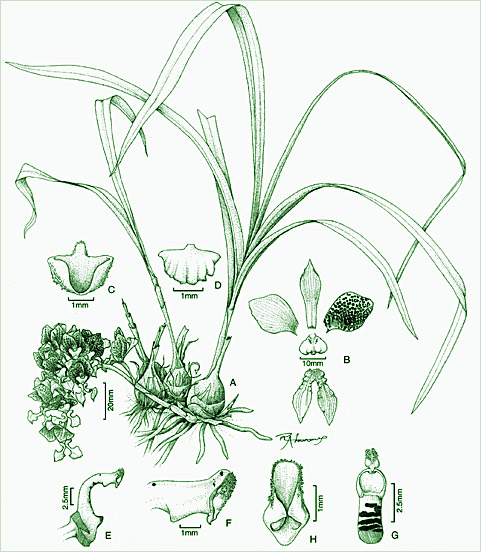 |
Grobya
amherstiae Lindl. (Botanical Register - 20: pl. 1740. 1835) Color: The sepals are yellow and the petals are pale yellow with brown dots. The trilobed lip is pale yellow with brown apex. Inflorescence: many-flowered, 1-2 per pseudobulb, suberect to arcuate. Blooming: It flowers mainly between February and May (end of summer to end of autumn in the southern Hemisphere). Habitat: It grows as an epiphyte in the shadow of wet forests, mainly in the Atlantic forest region, but reaching inland forest in the states of Minas Gerais and Bahia. |
Figure
1. Grobya amherstiae. A. habit - B. floral dissection - C .midlobe of the lip (ventral view) - D. midlobe of the lip (dorsal view) - E. column (lateral view) F. apex of column (lateral view) - G. column (ventral view), showing the dislodged anther cap - H. anther cap (ventral view). |
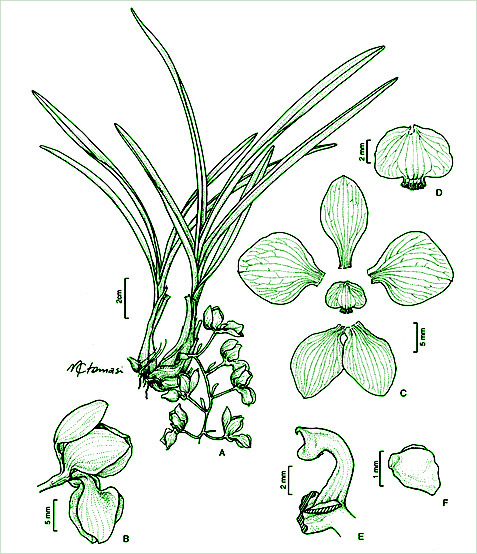 |
Grobya
cipoensis
F. Barros & R. Lourenço (Botanical Journal of the Linnean Society, 2004, 145(1): 120, 122-123 2004) Type: Brazil, Minas Gerais: Santana do Riacho, Serra do Cipó. Color: The sepals are yellow and the petals are yellow with brown dots. The trilobed lip is yellow and the column is white with purplish-brown transverse lines. Inflorescence: a few-flowered raceme, one per pseudobulb, hanging to arcuate. Blooming: In cultivation, January 1997. Habitat: It comes from the highland vegetation known as "campos rupestres" (rocky fields) in the state of Minas Gerais, where it grows as an epiphyte only on Vellozia gigantea N. L. Menezes. |
Figure
2. Grobya cipoensis sp. nov. A- habit / B- Flower (lateral view) / C- Floral dissection / D- Lip / E- Column (lateral view) / F- anther cap (lateral view) |
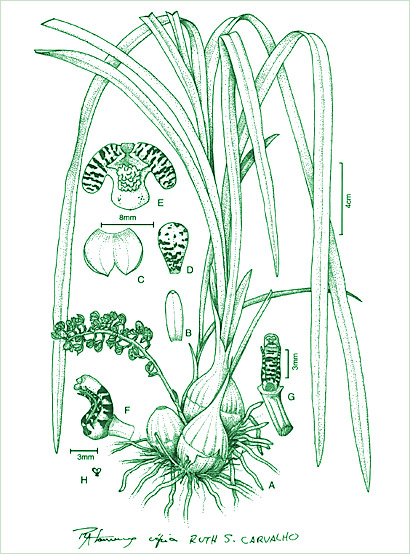 |
Grobya
fascifera Rchb. f. (Flora 69: 551. 1886) Synonyms: Grobya bibrachiata Hoehne Grobya bibrachiata var. riograndensis Pabst Grobya galeata sensu Kraenzl. Color: The small flowers are pale yellow. The petals are yellow with purplish-brown dots. The trilobate lip is yellow with purplish-brown dots. Inflorescence: many-flowered, 1-2 per pseudobulb, suberect to arcuate. Blooming: It flowers from March to April (end of summer to beginning of autumn). Habitat: It grows at an epiphyte in the Atlantic Forest, in the southern and south-eastern Brazil. |
Figure
3. Grobya fascifera A- Habit / B- Dorsal sepal / C- Lateral sepals / D- Petal / E- Lip (frontal view) / F- Column (lateral view) / G- Column (ventral view) / H- Pollinarium (based on the original colour plate publishrd by Hoehne, 1934. as G. bibrachiata). |
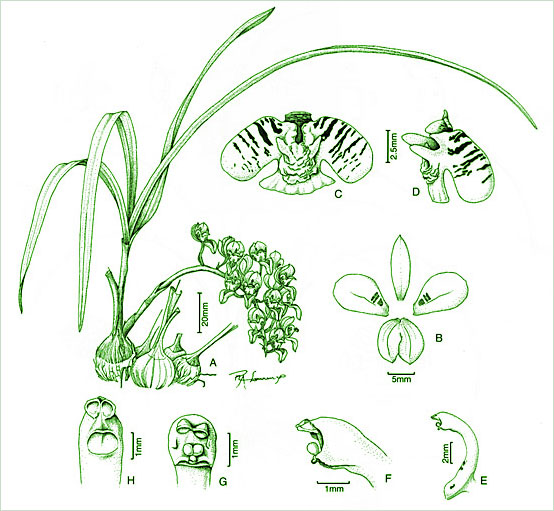 |
Grobya
galeata Lindl. (Edwards's Botanical Register 26: Misc. 83. 1840) It is related to G. fascifera differing mainly regarding the shape of the midlobe of the lip. Color: The flowers are yellow. The petals are yellow with brown dots. The lip is trilobate. Inflorescence: many-flowered, 1-2 per pseudobulb, arcuate. It is normally collected in the states of Santa Catarina, São Paulo and Rio de Janeiro. Habitat: It grows as an epiphyte in the Atlantic forest and flowers during the autumn, from March do May. |
|
Figure
4. Grobya galeata A- Habit / B- Floral dissection (except lip) / C- Lip (frontal view) / D- Lip (lateral view) / E- Column (lateral view) / F- Apex of column (lateral view), showing dried anther and pollinarium / G- Apex of column (frontal view), showing dried anther and pollinarium / H- Apex of column (ventral view), showing dried anther and stigmatic cavity |
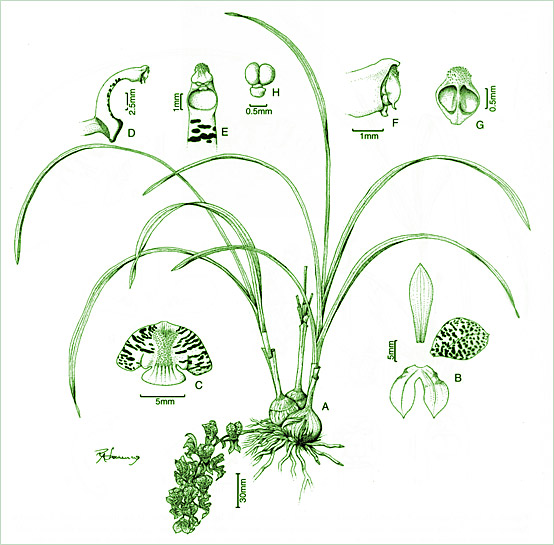 |
Grobya
guiselii F.
Barros & Lourenço
(Botanical Journal of the Linnean Society 145(1): 125-127 2004) Type: Santa Catarina, Joinville. Color: The petals are yellow as well as the petals which have brown dots. The trilobed lips also yellow with brown dots. Inflorescence many-flowered, two for pseudobulb, suberect to arcuate. It is similar to G. galeata, but has larger flowers, and a shorter and denser inflorescence. It is known only from cultivated plants coming from the Atlantic forest region in the state of Santa Catarina. |
Figure
5. Grobya guieselii sp. nov. A- Habit / B- Floral dissection (except lip) / C- Lip / D- Column (lateral view) / E- Apex of column (ventral view) / F- Apex of column (lateral view) / G- Anther cap (ventral view) / H- Pollinarium |
|
Key to the species of Grobya |
| 1. | Lip trilobed near the apex, the median lobe small, disc without a callus. | ||
| 2 | Sepals with an acute to acuminate apex; lateral lobes of the lip making an acute angle with the median lobe; lateral sepals long and narrow (18-20 x 4-7mm) | 1.
G. amherstiae |
|
| 2' | Sepals with an acute to obtuse apex; lateral lobes of the lip making an obtuse angle with the median lobe; lateral sepals short and broad (12 x 9mm) | 2.
G. cipoensis |
|
| 1' | Lip trilobed near the middle; median lobe very conspicuous; disc with distinct calli | ||
| 3 | Mid lobe of the lip ligulate | 3.
G. fascifera |
|
| 3' | Mid lobe of the lip obtrullate to obritriangular | ||
| 4 | Flowers small (petals c. 8-11 mm long, mid lobe of the lip c. 2-33mm long) | 4.
G. galeata |
|
| 4' | Flowers large (petals c 14-16 mm. long, mid lobe of the lip c. 6 mm long) | 5.
G. guieselii |
|
Distribution
by states: |
|
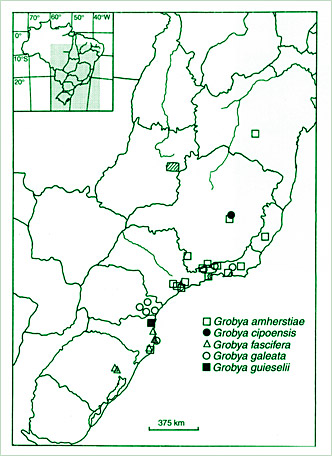 |
Bahia:
G. amherstiae Espírito Santo: G. amherstiae, fascifera Minas Gerais: G. amherstiae, cipoensis Paraná: G. amherstiae, fascifera, galeata Rio Grande do Sul: G. amherstiae, fascifera Rio de Janeiro: G. amherstiae, fascifera, galeata Santa Catarina: G. amherstiae, fascifera, galeata, guiselii São Paulo: G. amherstiae, fascifera, galeata |
| (*) Authorized by Fabio de Barros |
| Expressamente
proibido qualquer tipo
de uso, de qualquer material deste site (texto, fotos, imagens,
lay-out e outros), sem a expressa autorização de
seus autores. Qualquer solicitação ou informação
pelo e-mail bo@sergioaraujo.com |